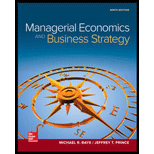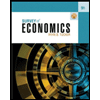
To know:Whether $200 to be invested or not.
Explanation of Solution
There are two firms: TT and ST
Following is the cost function of TT:
Following is the cost function of ST:
Following is the inverse demand function:
There exists cournot oligopoly between two firms which sells homogeneous product. Profit maximizing condition is as follows:
This implies:
Reaction function of TT firm is given as:
There exists cournot oligopoly between two firms which sells homogeneous product. Profit maximizing condition is as follows:
This implies:
In cournot oligopoly, equilibrium is attained when reaction function of both firms are solved simultaneously.
This implies:
Solving both the equations,
Thus, equilibrium output of TT is 26 and of ST is26
The equilibrium market price is given by:
Profit is calculated by subtracting total revenue and total cost. For TT firm,
Profit is calculated by subtracting total revenue and total cost. For ST firm,
Now, Stackelberg duopoly is followed in which cost functions are same but TT firm is leader and ST is follower.
Under stackelberg duopoly model, profit maximizing condition is as follows:
This implies:
The leader firm TT in Stackelberg duopoly takes into account the reaction function of the follower firm when it selects QTT.
The profit of the leader firm is given by:
The leader firm chooses QTT that maximizes the given profit function.
Hence, QTT that maximizes the profit function of the leader firm is:
Hence, the equilibrium output level for the leader firm is 39.
Calculation of equilibrium output:
Firm St has 19.5 units of output.
Calculation of equilibrium price:
Calculation of profit of TT firm is as follows:
Calculation of profit of ST firm is as follows:
Thus, the equilibrium profit of the leader firm TT under the conditions of Stackelberg oligopoly is $1521, which is higher by $169, compared to the equilibrium profit of $1352 of the firm TT under the condition of Cournot duopoly.
The unrecoverable fixed investment is $200, greater than $169.
That means, the firm TT should not invest $200 as the cost of establishing the first mover advantage exceeds the benefits.
Introduction:
Duopoly is a form of oligopoly market in which there are two firms selling goods in a competitive market where consumer’s choice does not affect them.
Want to see more full solutions like this?
Chapter 9 Solutions
Gen Combo Managerial Economics & Business Strategy; Connect Access Card
- how commond economies relate to principle Of Economics ?arrow_forwardCritically analyse the five (5) characteristics of Ubuntu and provide examples of how they apply to the National Health Insurance (NHI) in South Africa.arrow_forwardCritically analyse the five (5) characteristics of Ubuntu and provide examples of how they apply to the National Health Insurance (NHI) in South Africa.arrow_forward
- Outline the nine (9) consumer rights as specified in the Consumer Rights Act in South Africa.arrow_forwardIn what ways could you show the attractiveness of Philippines in the form of videos/campaigns to foreign investors? Cite 10 examples.arrow_forwardExplain the following terms and provide an example for each term: • Corruption • Fraud • Briberyarrow_forward
- In what ways could you show the attractiveness of a country in the form of videos/campaigns?arrow_forwardWith the VBS scenario in mind, debate with your own words the view that stakeholders are the primary reason why business ethics must be implemented.arrow_forwardThe unethical decisions taken by the VBS management affected the lives of many of their clients who trusted their business and services You are appointed as an ethics officer at Tyme Bank. Advise the management regarding the role of legislation in South Africa in providing the legal framework for business operations.arrow_forward
 Managerial Economics: Applications, Strategies an...EconomicsISBN:9781305506381Author:James R. McGuigan, R. Charles Moyer, Frederick H.deB. HarrisPublisher:Cengage Learning
Managerial Economics: Applications, Strategies an...EconomicsISBN:9781305506381Author:James R. McGuigan, R. Charles Moyer, Frederick H.deB. HarrisPublisher:Cengage Learning
 Survey of Economics (MindTap Course List)EconomicsISBN:9781305260948Author:Irvin B. TuckerPublisher:Cengage Learning
Survey of Economics (MindTap Course List)EconomicsISBN:9781305260948Author:Irvin B. TuckerPublisher:Cengage Learning Managerial Economics: A Problem Solving ApproachEconomicsISBN:9781337106665Author:Luke M. Froeb, Brian T. McCann, Michael R. Ward, Mike ShorPublisher:Cengage Learning
Managerial Economics: A Problem Solving ApproachEconomicsISBN:9781337106665Author:Luke M. Froeb, Brian T. McCann, Michael R. Ward, Mike ShorPublisher:Cengage Learning





